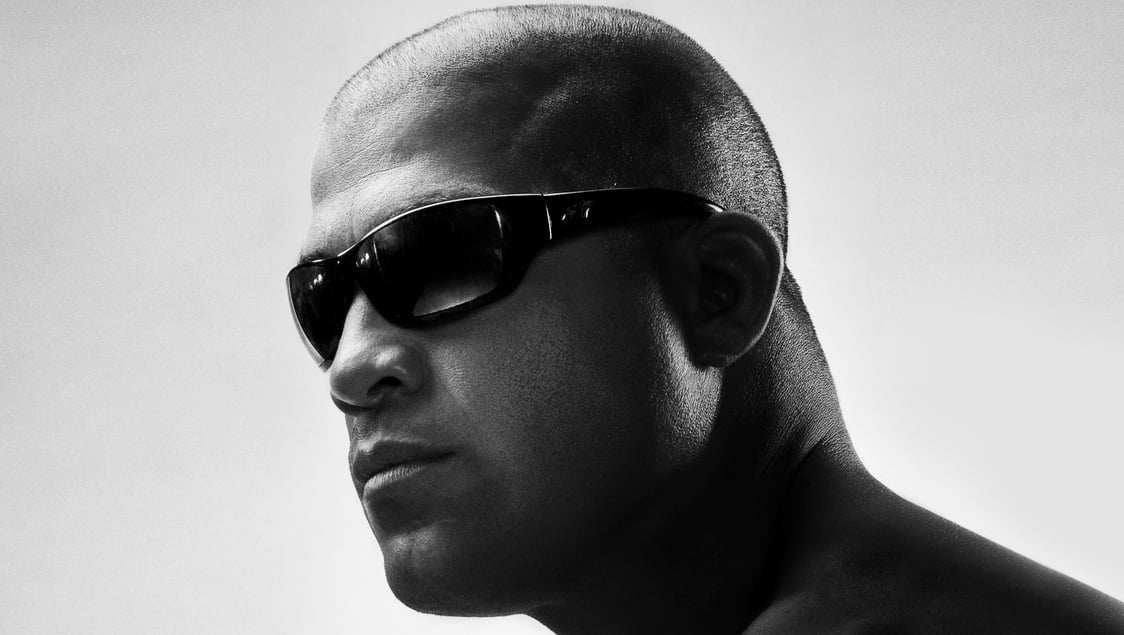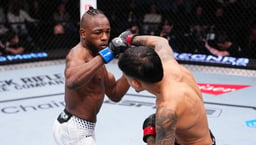
Issue 095
December 2012
Tito Ortiz was one of mixed martial arts’ first international superstars, helping the UFC turn into the fastest-growing sport on the planet. In the aftermath of his retirement, he speaks exclusively with Fighters Only about his 15 years in MMA
How many times over the years have you been at a mixed martial arts event, or even watched a guy train in the gym, and heard someone mutter the words, ‘This guy’s the next Tito Ortiz’? More than once I’d beg to guess. And, yet, it wasn’t just inside the Octagon where Huntington Beach’s finest blazed a trail for others to follow. Outside of it, too, he was a true pioneer. Make no mistake, there will only ever be one Tito Ortiz.
Despite the injury-riddled decline he suffered in the second half of his career, and the all-too-ugly public feuds with many of the other leading figures of his generation, Ortiz remains one of the most consuming characters in mixed martial arts. Much more than just a fighter, he’s quite literally a one-man brand and his retirement from the sport this summer, whilst inevitable, was also one of the most forlorn days in the UFC’s double-decade history.
The answer to where mixed martial arts would be today without Tito’s influence is naturally a speculative one. But few combatants in the history of the sport have left such a lasting impression – both on the fans and the Octagon’s future – as the former ‘Huntington Beach Bad Boy’ turned ‘People’s Champion.’
His record-breaking reign as UFC light heavyweight champion from April 2000 to September 2003 remains untouched. In the early to mid-2000s he was the biggest pay-per-view draw in the organization, thanks largely to his infamous rivalries with Chuck Liddell, Ken Shamrock and Forrest Griffin. And, most importantly to Ortiz himself, he walked away from the sport when he decided the time was right, rather than when he was forced, or when his broken body demanded it.
In an exclusive with Fighters Only, Ortiz looks back over his illustrious 15 years inside the world’s toughest fighting arena. He reveals how both the highs and lows of his career were spawned out of a childhood ravaged by drugs. He reviews the feuds that became synonymous with his reign, and how his quest to secure a legacy drove him to overcome one debilitating injury after another.
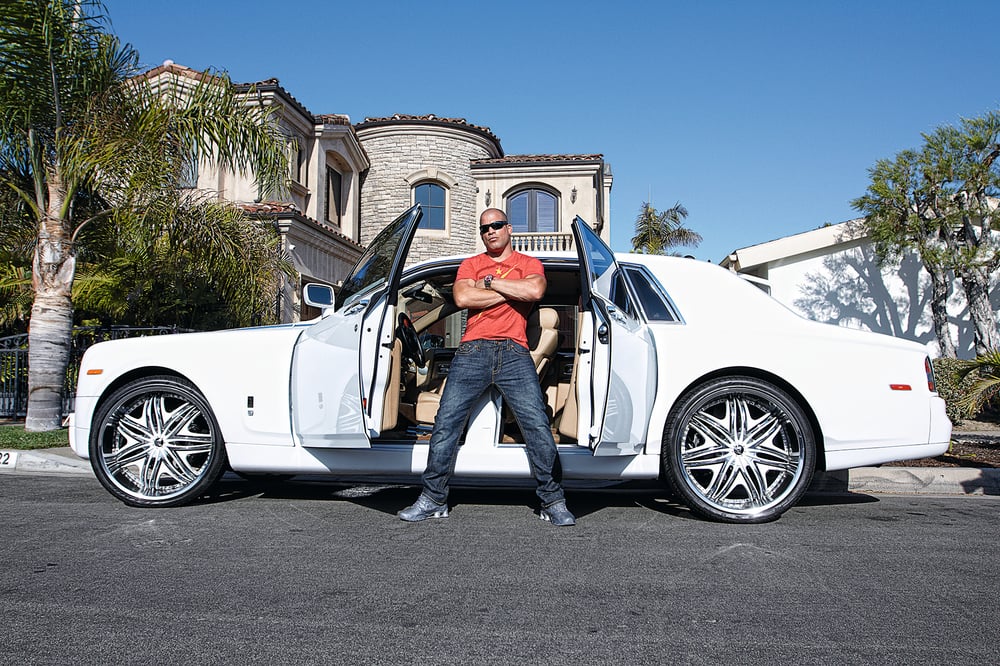
First of all, however, he’s keen to thank the loyal fans for the role they played in his fighting life. Without them he would have quit a long time ago. Without them, he admits, Tito Ortiz would not be in the Hall of Fame.
“I just wanna offer a big thanks to all my fans, the ones who stuck with me throughout my career,” Tito says. “They played a part in putting me here, into the Hall of Fame. I think 50% is down to me, but 50% is down to the fans, who have supported me over many years through thick and thin. There’s been a lot of people who jumped on the bandwagon too, but I always had a big loyal group of fans also, who stood by me during the wins and when I lost. And it’s those I want to thank most: the true fans.
“I feel like I’ve been on one hell of a journey for the past 15 years. I feel like everything there is to experience in this sport I’ve done. From the highest high to the lowest low. I’ve had the injuries, I’ve had the successes, and I’m thankful for all of it. I’m not a big Christian guy or a religious guy or anything, but I am thankful for the skills that were given to me. And also for the opportunities I got along the way.”
Opportunities that would likely never have surfaced had Ortiz not bumped into an old wrestling coach on one drug-fueled night in 1996. At the time, Tito was barely out of his teens, hanging in a gang, doing drugs, and skipping from one dead-end job to the next. Whatever it took to pay the bills. But wrestling coach Paul Herrera changed all that, and set Ortiz on the path to salvation.
“I was turning into my parents, and I hated it,” says Tito, who for eight years from the age of five lived out of trailer parks and people’s garages when his parents became caught up in drugs. “He helped me get financial aid so I could go back and wrestle at college. It turned my life around. When I was in college I wanted to go back to high school and become a teacher. I wanted to be a special education research teacher and help kids get off of drugs and stay in school, and also be a wrestling coach. But making $50,000 a year wasn’t going to take care of the big family I wanted to have.”
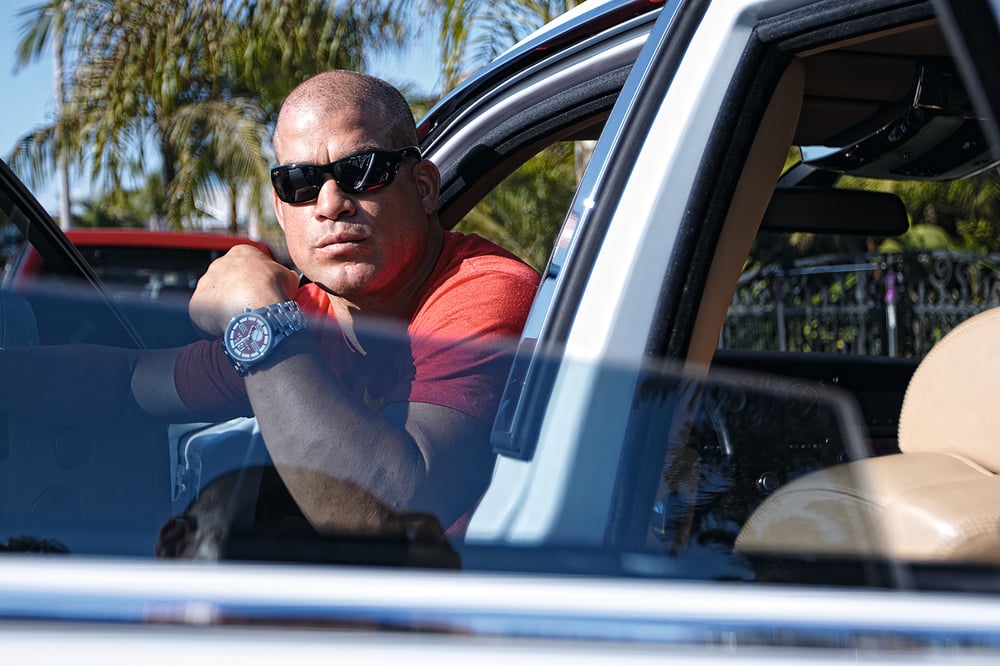
Salvation
Herrera again played a part, introducing Tito to UFC vet Tank Abbott, and, after a successful stint as a sparring partner, Ortiz was soon stepping into the Octagon himself. “When I fought the first time at UFC 13, I fought for free. I was an amateur and I fought just because I was excited and I wanted to try it out. I fought and stopped the guy (Wes Albritton) in 30 seconds.
“Later that night, I fought Guy Mezger and I lost to him, but I went away and I knew I wanted to keep doing this. The next time I came and earned $25,000 for one fight and I thought, ‘Wow!’ Then the next fight I got $40,000, the next fight $60,000, and it just went up from there. Things just got bigger, and bigger, and bigger.
“But, honestly, at first, I just did it because it was fun. And I didn’t have to wait to get into clubs, and once I did get inside I never had to pay for alcohol. So I just thought, ‘This is cool.’ But I think the competition was what kept bringing me back to it: to be the best guy in the world. To become the best I could possibly be. That was stuck in my head.
“Soon, the guys would be going out, going to clubs, and calling, asking, ‘Tito, come out with me, come out with me.’ But I’d just be like, ‘No, I’ve got to train. I wanna be a world champion so I gotta train.’ And that was just stuck in my mind. It was in my head and I just wanted it. I trained so hard to make it happen, and it happened.”
In those early days, Tito admits he wasn’t even hitting mitts or sparring, just wrestling and rolling jiu-jitsu. And in fact it was perhaps a surprising fighter who eventually inspired Ortiz to start training stand-up. “It was actually watching Frank Shamrock. I used to watch his boxing and I hated the fact that I looked up to this guy because of his striking. But I just thought, ‘If he can punch like this, then I can punch like this.’
“When I fought him, I was getting the better of him, then he caught me in a choke but I got out of it. Then he was just hitting me in the head and the match was over. Afterwards, I just thought, ‘Alright, I’ve got to make myself better.” And it was the 1999 fight of the year loss that led Ortiz to fully commit his entire life to training.
He adds: “I think it happened right after the Frank Shamrock fight. After that fight all I did was eat, sleep and train; eat, sleep and train. I wanted to go to Frank Shamrock’s and train with him, because he beat me, but he retired. So I thought, ‘I’m gonna learn something from this guy.’ So I went and started using heart rate monitors and learned about taking my heart rate through the roof and then bringing it back down in 30 seconds. And then I came right back and beat Wanderlei (Silva) for the title and went on my five-fight win streak.”
Outpointing Silva for the vacant title in Tokyo, Japan, at UFC 25, propelled Tito to the very top of the 205lb division. Yuki Kondo’s neck crank submission, in the same city eight months later, was then followed by the legendary KO slam of Evan Tanner in February 2001 – and also framed another new aspect in Tito’s career – that of his Big Bear training camp.
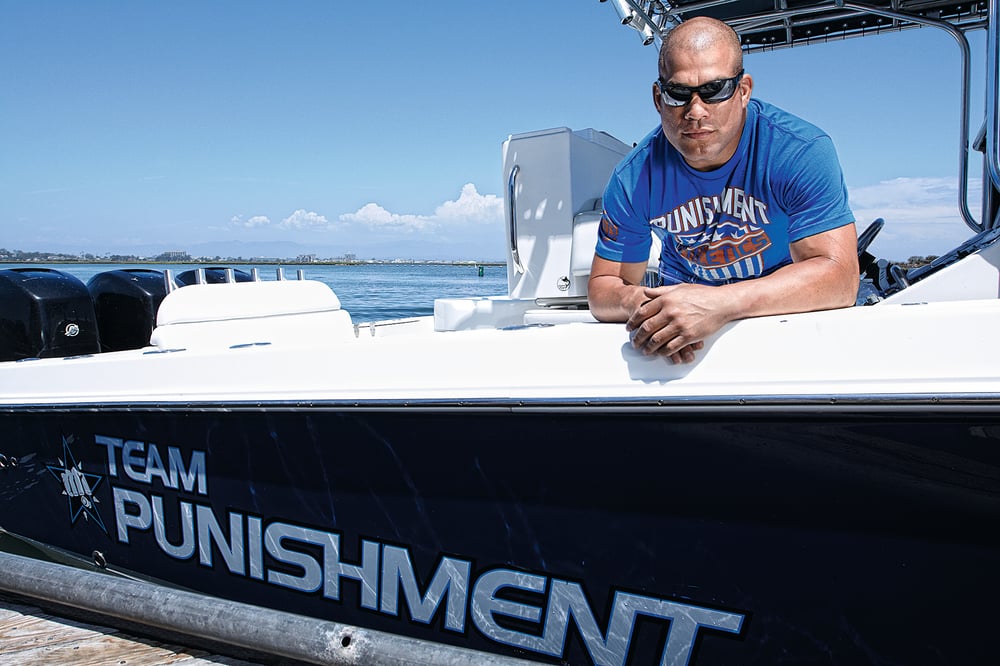
X-Men: First class
Purchased from multiple boxing world champion Oscar De La Hoya, Tito’s Big Bear ranch would become his training HQ for the rest of his career. And he reveals the switch actually came not from his fellow Mexican-American champion, but from the UFC’s new owners.
“The first time I ever went up there, Lorenzo Fertitta was the one who paid for my camp. He said, ‘Mike Tyson does it, Lennox Lewis does it, Fernando Vargas does it and Oscar too, so now you need to do it.’ So I went up there for seven weeks and he paid for everything, and it was hell!” Tito reveals. “But when it came to fight time, defending my title against Evan Tanner – God rest his soul – I stopped him in 30 seconds and I couldn’t believe it. All that work I’d done for seven weeks was over in just 30 seconds. But I felt phenomenal, so I just kept going back and doing it. Eventually buying De La Hoya’s place, of course,”
Now up for sale, although Tito hopes to offer it up for a series of The Ultimate Fighter, the state-of-the-art training base – approximately two hours from LA – played a significant role in the early days of the UFC, not only in the career of Ortiz. Back in the early noughties he was joined at the facility by Liddell, ‘Rampage’ Jackson and Ricco Rodriguez – to name but a few – a relative who’s who of UFC legends. Yet Tito says: “At the time we never thought like that at all. We didn’t dream of becoming legends or icons or anything like that.
“At the time we were just trying to hold this sport together and try and make it as fan-friendly and mainstream as possible. We worked hard to make this thing acceptable to modern society, that’s genuinely what we were more concerned about. Making MMA as big and accessible as possible. When people would say it was barbaric, we’d say, ‘Watch closely at the moves we do. We’re the most talented and dedicated fighters in the world.’ You watch boxers and they’re boxing to survive, but we are fighting to educate people.”
Big Bear soon brought further success. Ortiz used his trademark ground ‘n’ pound to smash Elvis Sinosic at UFC 32 in June 2001, registering his third successive first-round finish in the process, before outpointing future IFL light heavyweight champion Vladimir Matyeshenko at UFC 33 on his Las Vegas debut. And then came the crowning moment of Tito’s reign: UFC 40 and Ken Shamrock.
By now the rivalry between the pair was at fever pitch. Shamrock was the chief protagonist of the Lion’s Den camp, with which Ortiz had been embroiled in a war of words ever since avenging his early career loss to Guy Mezger in his fifth fight. Tito recalls: “I actually didn’t go into that thing with the Lion’s Den guys to make myself the bad guy – not at all. I was just standing up for myself.
“Here was this group of fighters who were pretty much the Cobra Kai from the Karate Kid, and they thought they were badass and everybody would take their s**t. But I wouldn’t take their s**t. I stood up for what I believed in. So I stood my ground, even though there was like 10 of those guys and only two of us. I stood my ground.
“In the first fight against Mezger I was p**sed that they stopped the fight. I got choked out and I promised that wouldn’t happen again, and it just built. It just got worse, and worse, and worse. I mean, those guys were walking around with the shoulders all up high and their elbows up, and they were just bullies. But I was just the bully-basher, I guess you could say. And I took them apart one by one. First I went back to Mezger, then on to Jerry Bohlander and then on to Ken Shamrock.”
The victory for Ortiz, after Shamrock was pulled by his corner team at the end of the third round, was not only significant for the champion, it was also monumental for the UFC. Pay-per-view sales quadrupled, and for the first time, new owners Zuffa could see a light at the end of the tunnel of mainstream acceptance. UFC 40 proved mixed martial arts had a future, with Tito Ortiz as MVP.

Injuries
Unfortunately, according to Tito, UFC 40 would also be the last time he would ever step into the Octagon injury free. The record five-defense reign came crumbling down after his first back injury led to a unanimous points defeat to fellow Hall of Famer Randy Couture at UFC 44 in September 2003. And for the next nine years Tito would be in a constant battle with the toughest opponent of his career – his own body.
“Through my whole career, my worst opponent was myself: my own body. Despite all these injuries, man, I was able to bounce back and fight again. Finding the motivation to do that, to keep coming back, that was my biggest challenge. That was definitely my toughest opponent.
“I came through some major surgeries and fought again when I was told I never would. And the injuries never retired me either, I retired because I was done. I put 15 years of my life into the sport and I’m proud that I was able to walk away on my terms.”
And despite what surgeons told him, there were plenty of good times to follow. From October 2004 through to October 2006, Ortiz went on another five-fight unbeaten campaign that featured the scalps of Patrick Cote, Vitor Belfort, Forrest Griffin and back-to-back TKOs of old foe Shamrock – completing a perfect treble against his rival, and now fellow UFC Hall of Fame star.
Unfortunately, the period also featured the only regret Ortiz has about his career. Whilst he’s vehemently proud about the fact he stood up for his rights, and refused to sway regarding what he believed he deserves to get paid as a fighter, his public bust-up with UFC president Dana White leaves a bitter taste in his mouth.
He says: “That’s the only thing I regret – the things that I said about Dana (White). The battles we had back and forth. I know now that I overstepped my boundary, but I was young and that’s all I knew at the time. But you learn from your mistakes, and I learned from it. I was just trying to stand up for my family and stand up for myself, as a fighter. I didn’t have a manager to stand up for me, so I stood up for what I believed in, and I tried to stand up for fighters in general.
“Getting paid the money we did at the time, I didn’t believe it was even close to what we should be getting. After doing all the hard work in the gym and then all the press and PR – I was going out to Iraq and really working hard to keep my name out there – so I thought I deserved a certain amount. I wanted to get to that point where I was receiving what I deserved. And fighters need to do that now. Don’t be a p**sy. Stand up and fight for what you deserve. Don’t let people walk over you. I didn’t, and I got what I deserved.”
He adds: “But it was never ever personal. It was never about getting one over on Dana, it was never about getting one over on the Fertittas, or getting one over on the UFC, or damaging the UFC. It was just that I saw this window of opportunity as a fighter, knowing that I couldn’t be a fighter for the rest of my life, to get the money to take care of my children. To secure the future for my kids.”
The brand
Securing a future for his family was always top of the Ortiz agenda, and he revolutionized the sport with his self-branding practices. Tito believes that fighters today, at every level in the sport, should follow the path he laid with his own blood, sweat and tears.
“Creating a brand around yourself is very, very important,” he offers. “I was the first guy to make fighter cards, just 8-by-10s, even before Topps came out. I was the first guy to do that as I wanted fans to go home with something with my face and name on it, so that’s what I did. And right now I’m onto my 17th edition and each time I’ve made 10,000 of them, so I’ve given out 170,000 cards throughout the world. And I backed all the promo stuff up by speaking my mind, not biting my tongue but simply by being me. I speak my mind and I speak the truth, and I think that’s why the fans love me so much.”
Some may call it talking trash, but Ortiz doesn’t care what it’s labeled, only that it’s imperative to any fighter looking to make the bug bucks. He adds: “At the end of the day it comes down to the individual. You’ve got to do the extra work. You’ve got to take things like speech classes. You’ve got to do that extra work to make the difference.
“It’s not enough just to turn up and fight; it’s not. Look at Chael Sonnen. The guy talks so much, but he’s a good fighter and he sells tickets and pay-per-views – whether people want to see him win or lose. As long as people are talking about you, even if they’re hating on you, that’s what matters. ‘Cos when they stop talking, that’s when you’ve gotta get worried.”

And nobody ever stopped talking about Tito. He made sure of that. Alongside his Hall of Fame career was also his Punishment Athletics brand, which has been in existence since 1999. “Punishment, man, we’re just getting bigger and bigger year on year and we’ve proved we’re not just a flash in the pan. It’s my company. I’m the one who goes out and works on the designs, I’m the one who gets fighters to wear the stuff. I approve everything, I approve the color schemes. Either I wear Punishment or I wear suits. That’s all I wear.”
So how does he feel about sportswear giants like Nike stepping into the Octagon for the first time? “I think it’s great. It shows the sport has really taken off. It’s an acknowledgement that MMA is now one of the highest-grossing sports in the world, and big companies like that are great for the sport.”
The future
So what about the UFC Ortiz leaves behind? After their 15-year relationship, tumultuous yet highly beneficial for both, who does Ortiz believe is the next generation of superstar capable of taking the UFC forward in this decade? “(Junior) Dos Santos, the heavyweight champion, he’s very, very good. I love it when he walks out and points to the canvas, like I always did. I think it’s awesome. He can have it and I love it every time he does that.
“I’m thankful that he does that, as it shows respect. That’s really cool. He’s a guy I think can dominate the heavyweight division for a long time – especially with the power in those hands he has. The only thing that will be a problem for him will be injuries. Injuries are the toughest opponent for any fighter. They’re so hard to come back from, so difficult, so mind-challenging, that it’s just like no other opponent.”
He adds: “Jonny ‘Bones’ Jones too, I think he’s great. He just needs to learn a little bit of respect, rather than the bad things he’s been saying about me. And Georges St Pierre, but we’ll have to see how he fares after knee surgery. Injuries are a test that fighters never understand until they have them. When your body starts breaking down, that’s when they’ll think, ‘Holy s**t, Tito wasn’t joking.’ That’s what it comes down to: you’re invincible, until you get an injury.
“I was in the same position Jon Jones is at now; I was invincible. Then I got a back injury and from then on my body was just destroyed. It’s just been deteriorating. I hope Georges doesn’t have the same problems, I really don’t, as he’s an awesome guy. I really hope he comes back and picks up where he left off.”
That’s something Oritz was never able to do. With back and neck surgeries becoming as regular as Christmas, the final years of his career suffered under the strain of the surgeon’s knife, and eventually, after almost having to beg for his swansong, a match was made with Ryan Bader at UFC 132.
White commented before the fight it was “definitely do or die for him.” Do or die. For approximately two minutes in Las Vegas on July 2nd 2011, Tito was back.
He recalls: “My top-three favorite career moments were: beating Wanderlei Silva for the world title. Headlining in Las Vegas in the first ever UFC pay-per-view against Vladimir Matyushenko, which was a fill-in two weeks before the fight ‘cos Vitor (Belfort) got hurt. And then last but not least is Ryan Bader, when my back was pushed up against the wall and I had everything to lose. Financially, for my family, for my fans, for my companies, everything was on the line. And I won. And then I came back a month later and fought Rashad Evans, the number-one contender – at two weeks’ notice.”
So, after 15 years, 28 fights, five UFC light heavyweight title defenses, countless surgeries, and soap opera drama, would he like to rewind the clock and do it all again starting today?
“Hell yeah! I’d love it. Of course…” he explodes, not for the first time in his career, allowing his mouth to beat his mind to his response. “But then, after a second, you know what, the truthful answer to that question is no. I’m happy with what I’ve done, and I’m happy to have stood my ground and put the fighters today in the position they are in. Who knows what shape this business would be in if it wasn’t for me standing my ground.”
Finally, Tito, who reveals eldest son Jacob – named after his father – has eyes on continuing the Ortiz name inside the Octagon, finishes by saying: “Again I wanna thank the fans for their support. And my beautiful wife Jenna too, for giving me two beautiful kids and also standing by me and supporting me right along the way. And, also, I wanna thank my family, of course. It’s nice now to be able to finally tell them that I no longer want to fight. I’m comfortable saying that now, and I know they’re glad to hear it.”
Tito's famous feuds
Ortiz on... Forrest Griffin
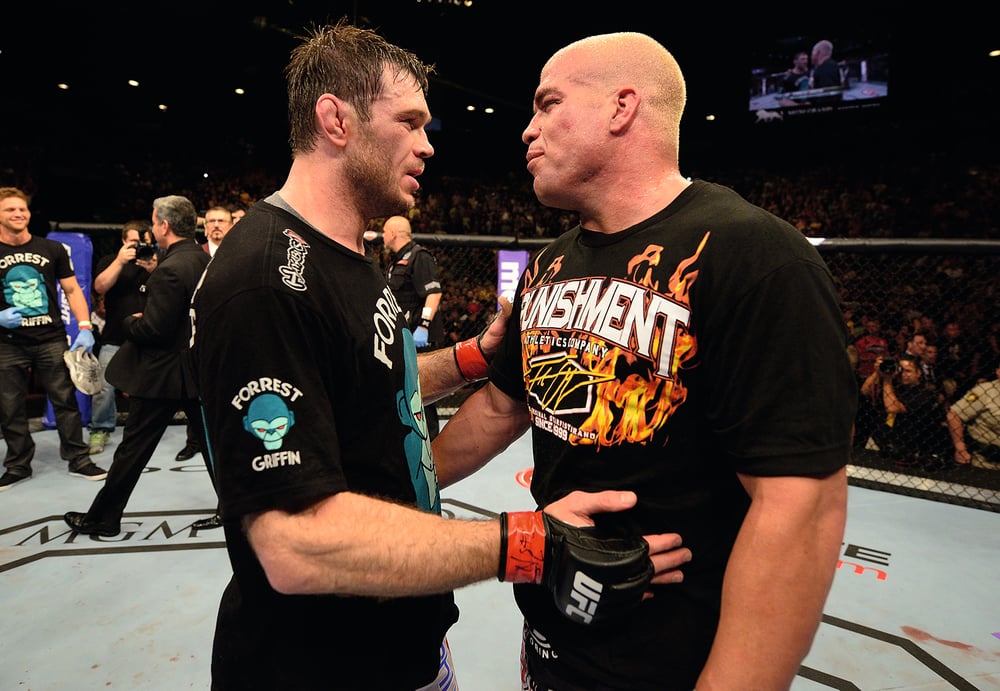
“My rivalry with Forrest was never anything more than that between two fighters, it was always just about the fight. But then Forrest was always trying to prove he was more famous than me. That was his job,” Tito says. “That was always their job, to hold me down, but for me it was just another fight. I was just trying to be the better fighter. And when you look at it, those fights were so damn close... Besides the last one, that was just ridiculous. But there is always a sense of controversy around it.”
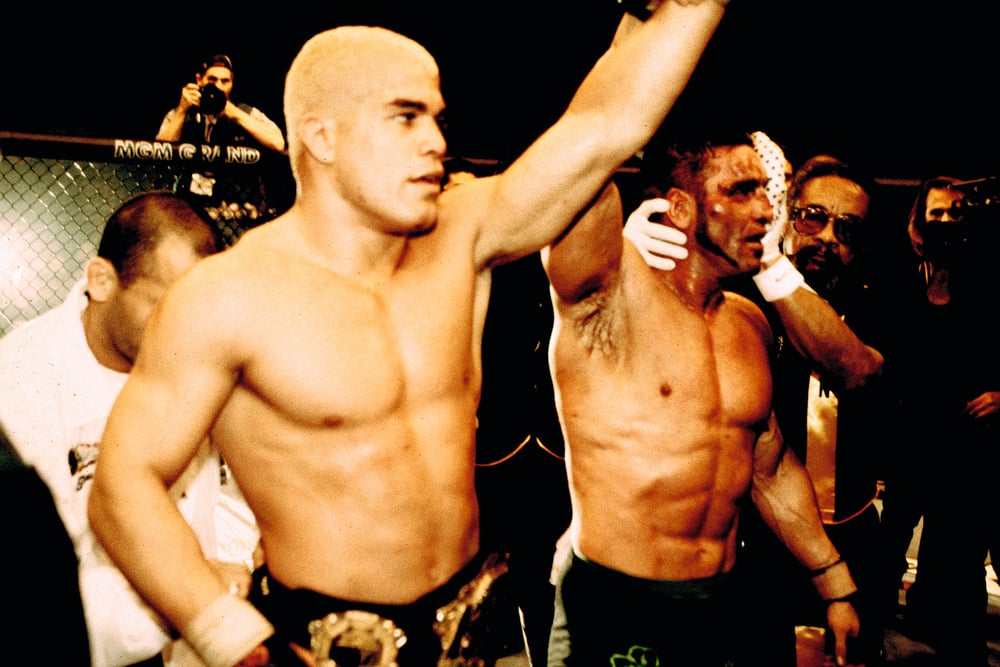
Ortiz on... Ken Shamrock
“I’ve not seen him for like five years now, but we were cool the last time we bumped into one another,” he reveals. “He was getting ready for a fight, I think, and I just said good luck to him and that was it.”
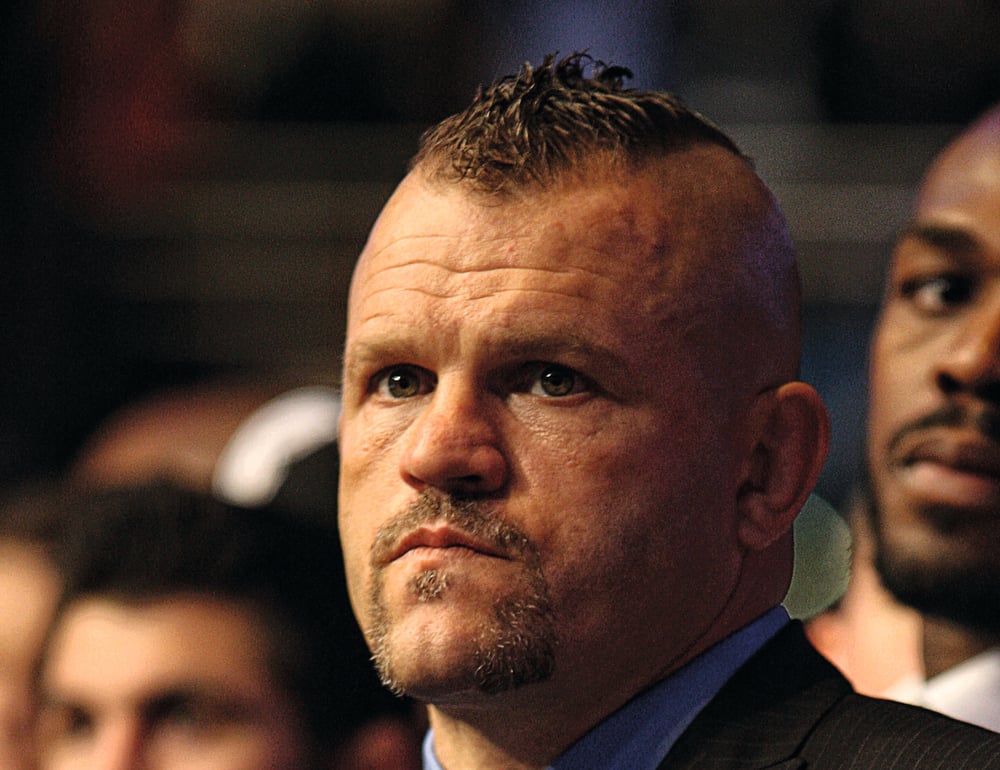
Ortiz on... Chuck Liddell
He adds: “The thing with Chuck is this, Chuck’s just two-faced, man. I’ll see him and say, ‘What’s up?’ and ask, ‘How you doin’?’ and then all of a sudden in a magazine article he’ll start talking s**t. That’s when you realize he’s like a puppy. And that’s it. But it’s fine. I know Chuck Liddell is one of Dana’s champions, so good for him. Let him live his life now, rather than living in my shadow.”
Back under the knife
Despite a career littered with trips to the surgeon, Tito Ortiz reveals that he’s got a couple more planned before the end of the year is out – simply to be able to live out the rest of his days, hopefully, pain-free.
He says: “I’m having my sixth or seventh surgery at the end of this summer. Neck and knee surgery again, for the last time… I’ve already had two knee surgeries, back surgery, neck surgery, wrist surgery. But I had no choice, man. The only choice I had was trying to fix it. When it’s bone on bone, with one disc in there just bone rubbing against bone in your neck and back, that’s painful. Once that nerve damage kicks in, man, it’s pain.
“This next surgery on my neck is on the disc two above my previous surgery. The one I had surgery on before is fine, no problems. But I’ve got to go back and have the same thing done to another disc. It needs replacing too. And, I also gotta get my ACL rebuilt, in my right knee.
“I tore it in the Forrest Griffin fight. In the run-up to my last fight I went in for surgery on the knee and they cut out 50% of the meniscus, then in the third round against Forrest I heard it pop. After the fight I got it checked out and the doctors said, ‘It’s a torn ACL.’ The knee is swollen even now; it hurts. But there is a lot of good fishing here in California right now so I’m gonna wait until the fishing season is over before I get it done.”

